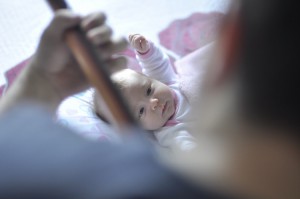
by Lela Nargi
There are some obvious differences between the rural Midlands of England, where Colette Linton-Meyer grew up, and brownstone Brooklyn, NY, where she and her family now make their home. Cows, for starters. Cowsheds, for another—including the converted cowshed in which, at age 3, she was introduced to dance by a beloved teacher who taught her students, above all, to love freedom of movement. There’s also at least one critical, but less overt, anomaly: “In Shropshire,” says Linton-Meyer, “there were more pubs per square foot. Here, there are more children.” For Linton-Meyer, more children could only mean: the necessity for a ballet school.
Cobble Hill Ballet, which Linton-Meyer founded in 2003, is a burgeoning business that employs 10 instructors to teach 79 classes comprised of some 800 kids—yes, mostly, but not only, girls—in two dedicated studio spaces within half a mile of each other. But its origins were significantly more diminutive. Linton-Meyer had recently given birth to her first son, Thomas, and was shuttling two hours round-trip every day to a ballet school in Rockland County to teach. “It was ridiculous,” she remembers. “I was pumping in the studio before teaching, and meanwhile, there was no place that taught ballet in Brooklyn. I knew I had to make a transition.”And not only because of the commute. Linton-Meyer, who graduated from the Royal Academy of Dance in London with a degree in Ballet Education, was unprepared for the intensity of the studio in Rockland. “It was competitive, and some kids went on to incredible things,” says Linton-Meyer. “But I thought it would be nice to have some sort of middle ground.”
With her musician husband, Ted, stepping in to help look after Thomas, Linton-Meyer started by teaching an afterschool class in a local public school. But, she says, “It was painful. We were in the middle of a very public auditorium, with loads of people walking through and talking.” In her off hours, she often took Thomas to a playroom at a neighborhood church. At some point, she hit on the idea of asking them if she could rent a space. “They showed me this room upstairs, which had had a fire, and holes in the floor. It was a disaster!” says Linton-Meyer. “But I could see it could be amazing.” The church renovated and indeed, the room did become amazing: a large, light-filled studio with painted pine floors and stained glass windows. All that was needed were pupils.

“I want to keep having this nurturing environment, so that ballet can be in these kids lives for a long time.”
“I used to tape up fliers along Court Street whenever I could,” laughs Linton-Meyer, recalling those renegade start-up days in the neighborhood. She’d had her second son, George, by the time she’d attracted her first three, tiny, students—including one current 8th grader who still dances with her. She started with one class; then before long was able to move up two classes; then hired her first teacher, known to every Cobble Hill Ballet student as Miss Alwyn; then began using the playroom downstairs at the church as a second studio, dragging toys and furniture out of the way, “Every day, for years,” says Linton-Meyer, the exhaustion still evident in her voice.
The school kept growing, and soon Linton-Meyer had hired several more teachers and was renting out space at three other locations around Brooklyn. “We’d be here one day a week, then two days a week there, and that was kind of tough.” Still, people kept finding her, mostly by that most Brooklyn of phenomena: word of mouth. By 2011, it became obvious that she needed a space to call her own.
What she found was a narrow, high-ceilinged storefront that had once housed a pie shop, along a block of Columbia Street, not far from the East River’s stevedore docks, that nevertheless has a family-friendly appeal, with a popular Mexican restaurant on the corner, a bakery just next door, and a ceramics studio several doors down. For the first time since she’d begun teaching, Linton-Meyer now had the chance to tailor a space to her own specifications. She soundproofed the room, put up a thick dividing wall between the studio and entryway—taking care to add a viewing window (“For the younger kids, it’s really important for their parents to be able to see them,” says Linton-Meyer, “even though the older kids don’t like it after a while.”). She also added an all-important sprung floor, which eases the trauma from leaps and hard landings on shins especially, topped with marley dance floor tiles. When a second space opened up several blocks south and east, in Carroll Gardens, Linton-Meyer did it all again.
Without having to worry any longer about shuffling classes from location to location, Linton-Meyer can now concentrate on the nitty-gritty of making Cobble Hill Ballet what she (and plenty of other local parents and kids) call the “happiest ballet school in Brooklyn.” She and her teachers adhere to a strict syllabus in order to allow her students the freedom to express themselves, but also to see a real progression in skills from year to year. “Dance gets harder as you get older, because of all the technical aspects,” says Linton-Meyer. “You have to constantly work to make it challenging and fun and not-boring, but also to get in all the good barre work, because I want to give my students real training.”
Although she has yet to see one of her ballerinas go on to a career in dance, Linton-Meyer concedes it’s not her primary focus. “In the ‘real’ ballet world, kids are going to class five days a week, and sometimes they hit age 16 and their bodies change and they’re just done,” she says. “But Brooklyn parents are more interested in their kids being well-rounded. And this place is a real community—the girls get to be good friends, and they have the year-end show, with the older kids helping out the younger kids. I want to keep having this nurturing environment, so that ballet can be in their lives for a long time.”

To learn more, visit Cobble Hill Ballet.
Photographs by Roy Beeson


